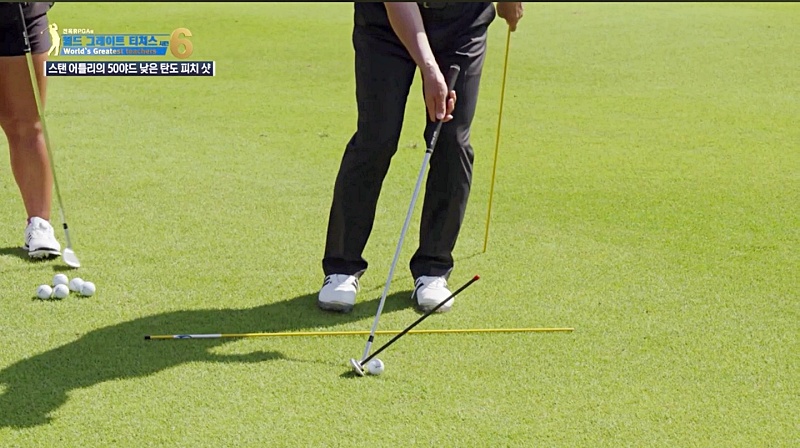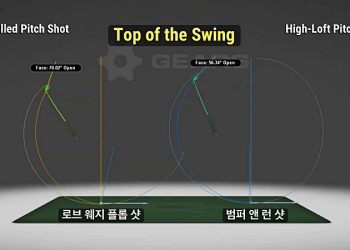파 5홀에서 투 온에 실패해 남게 되는 거리는 대부분 일정하다. 남은 거리가 40~60야드 정도라면 풀스윙이 아닌 피치샷을 하게 된다.
피치샷은 탄도가 높아 볼을 그린에서 쉽게 멈추게 할 수 있다. 하지만 맞바람이 심하면 이러한 샷을 시도할 수 없다.
맞바람이 강하고, 그린과 핀 사이에 공간이 좀 있다면 낮은 탄도로 약간의 드로우샷을 시도하는 것이 좋다. 그래야 정확하게 볼을 칠 수 있다. 볼의 탄도를 낮출수록 거리 조절이 더욱 정확히 할 수 있기 때문이다.
볼 탄도를 낮게 만드는 것은 볼의 런치 앵글을 줄이는 것과 관련이 있다. 그래서 이러한 웨지샷은 스탠스를 좁게 하는 것이 포인트다. 상체는 볼보다 앞으로 나가 있어야 한다. 임팩트 시 몸이 앞쪽으로 기울어져 있으면 다운블로 시에도 볼을 칠 수 있으며, 클럽이 볼보다 앞으로 나가 있어야 한다. 샤프트가 앞으로 나가 있다는 것은 클럽 페이스의 로프트 각도가 줄어든다는 의미다.

또 다른 키 포인트는 클럽 헤드 스피드를 내기 위해 몸의 회전만 사용하는 것이다. 약간의 손목 동작도 필요하지만, 대부분의사람들은 팔을 크게 들어 올려서 스윙을 크게 한다. 이렇게 큰 스윙으로 몸을 회전시키면 볼은 원하는 목표 지점보다 멀리 지나간다. 몸의 회전만을 사용하는 것이 팔을 크게 들어 올려서 하는 것보다 거리감을 정교하게 만들 수 있다.
자, 이제 실제 스윙 동작을 순서 있게 정리해 보자. 먼저 셋업 시 스탠스를 좁게 서고 양 발끝은 스퀘어로 취한다. 상체는 볼보다 앞쪽으로 기울인다.
백스윙할 때는 손목이 코킹되어 있고 팔도 구부린다. 그리고 정상적인 스윙처럼 골반의 회전을 한다. 이 샷에서는 회전을 많이 하기보다는 리듬을 만드는 것이 중요하다. 백스윙을 작게 하고 회전하면서 볼을 친다.
볼을 치고 나서 가슴이 타깃을 향하게 한다. 피니시 때 상체가 펴져 있어야 하고 어깨가 거의 평행이 되도록 한다. 즉, 오른쪽 골반도 목표로 완전하게 회전된 상태가 되도록 한다.
결과적으로 어드레스 때 만들어진 낮은 각도의 로프트 각이 임팩트 때도 이어지게 한다. 맞바람 상황에서도 거리감을 지키면서 볼의 스핀량도 높일 수 있다. 맞바람이 불 때 낮은 탄도로 치는 것이 쉽지 않다. 하지만 아래 요약된 내용을 기억해 두면 도움이 될 것이다
①기본 셋업
– 스탠스를 좁게 선다. / – 양 발끝을 스퀘어로 취한다. / – 상체는 볼보다 앞쪽으로 기울인다.
②백스윙
– 손목을 코킹하고, 팔을 구부린다. / – 골반 회전을 통해 정상적인 스윙을 한다. / – 리듬을 유지하고 백스윙을 작게 한다.
③임팩트와 피니시
– 임팩트 시 몸이 앞쪽으로 기울고, 샤프트가 볼보다 앞에 위치. / – 볼을 친 후 가슴이 타깃을 향하고 상체가 펴져 있음. /- 오른쪽 골반도 목표로 완전한 회전.
④샷의 목적
– 볼의 런치 앵글을 줄여 탄도를 낮춘다. / – 손보다는 몸의 회전 힘을 사용한다.
☞ 전욱휴는…
골프 칼럼니스트. PGA 클래스A 멤버이자 공인 티칭 및 코칭 강사다. SBS, MBC, JTBC, YTN 등의 골프 채널에서 진행자 및 해설자로 활약했다. 현재 애틀랜타에서 골프 레슨 및 골프 관련 비즈니스를 하고 있다. chungolf@gmail.com
[Dr.Eric Chun’s Golf Lesson] 19. Pitch Shot with Low Trajectory from 50 Yards.
“Keep a narrow stance and lean your upper body towards the target”
The distance remaining after failing to reach in two on a par 5 hole is usually consistent. If the remaining distance is 40 yards, 50 yards, or 60 yards, a pitch shot rather than a full swing is used. The pitch shot has a high trajectory and can easily stop the ball on the green. However, this shot cannot be attempted if there is a strong headwind.
When there is a strong headwind and some space between the green and the pin, it is better to attempt a low trajectory shot with a slight draw. This allows for a very accurate shot. The lower the ball’s trajectory, the more precise the distance control can be.
The most important thing for this shot is to first lower the ball’s trajectory. Lowering the trajectory is related to reducing the ball’s launch angle.
Therefore, for this wedge shot, the stance is kept narrow. Your upper body should be ahead of the ball. If your body leans forward at impact, you can still hit the ball on a down blow, with the club ahead of the ball. Having the shaft ahead means the loft angle of the clubface is reduced.
Another key point for consistent shots is to use body rotation only to generate clubhead speed. While a bit of wrist action is necessary, most people tend to lift their arms high and make a big swing. A big swing that involves body rotation will send the ball past the target. Using only body rotation allows for more precise distance control than lifting the arms high.
Now, let’s break down the actual swing sequence.
At setup, stand with a narrow stance and keep both toes square. Lean your upper body forward ahead of the ball.
During the backswing, cock your wrists and bend your arms. Rotate your hips as in a normal swing. In this shot, it is more important to create rhythm than to rotate a lot. Make a small backswing and rotate while hitting the ball.
After hitting the ball, your chest should be facing the target. At finish, your upper body should be straight, and your shoulders should be almost parallel. In other words, your right hip should be fully rotated towards the target.
Ultimately, the low loft angle created at address should continue through impact. This allows you to maintain distance control and high ball spin even in headwind conditions.
Although it is not easy to hit with a low trajectory in a headwind, remembering the summarized points will help.
1. Basic Setup
– Stand with a narrow stance.
– Keep both toes square.
– Lean your upper body forward ahead of the ball.
2. Backswing
– Cock your wrists and bend your arms.
– Rotate your hips as in a normal swing.
– Maintain rhythm and keep the backswing small.
3. Impact and Finish
– At impact, lean your body forward with the shaft ahead of the ball.
– After hitting the ball, your chest should face the target and your upper body should be straight.
– Fully rotate your right hip towards the target.
4. Shot Purpose
– Reduce the ball’s launch angle to lower trajectory.
– Use body rotation strength rather than hand action.
By doing this, you can hit the ball accurately even in a headwind.





![[전욱휴의 골프레슨]19. 낮은 탄도 피치샷](https://www.atlantajoongang.com/wp-content/uploads/2024/08/Q2KakaoTalk_20240801_080129340_02-750x422.jpg)













![[전욱휴의 골프 레슨] 46. 배치기(얼리 익스텐션)](https://www.atlantajoongang.com/wp-content/uploads/2025/03/photoKakaoTalk_20250306_073237889_01-350x250.jpg?v=1741361116)
![[전욱휴의 골프 레슨] 45. 임성재 '행온페이드' 샷](https://www.atlantajoongang.com/wp-content/uploads/2025/02/collage1-350x250.jpg)
![[전욱휴의 골프레슨] 44. 일관된 샷을 원한다면](https://www.atlantajoongang.com/wp-content/uploads/2025/02/QKakaoTalk_20250212_065748485-350x250.jpg)

![[전욱휴 골프 레슨] 42. 오른쪽 팔꿈치 역할](https://www.atlantajoongang.com/wp-content/uploads/2025/01/qQ1KakaoTalk_20250130_072058648-350x250.jpg)
![[전욱휴의 골프 레슨] 41. 매킬로이 파워 스윙](https://www.atlantajoongang.com/wp-content/uploads/2025/01/qQ1KakaoTalk_20250122_123635940-350x250.jpg)






